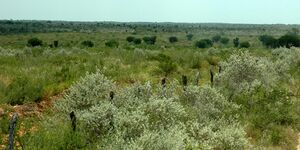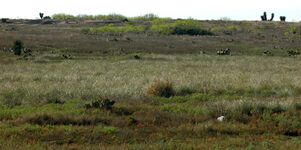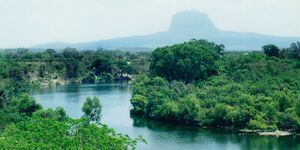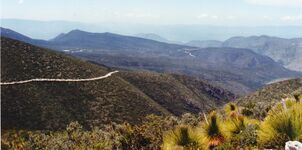تاماوليپاس
Tamaulipas | |
|---|---|
| Free and Sovereign State of Tamaulipas Libre y Soberano Estado de Tamaulipas (Spanish) | |
| النشيد: Himno de Tamaulipas | |
 State of Tamaulipas within Mexico | |
| الإحداثيات: 24°17′N 98°34′W / 24.283°N 98.567°W | |
| Capital | Ciudad Victoria |
| Largest city | Reynosa |
| Largest metro | Tampico |
| Admission | February 7, 1824[1] |
| Order | 14th |
| الحكومة | |
| • Governor | |
| • Senators[2] | |
| • Deputies[3] | |
| المساحة | |
| • الإجمالي | 80٬249 كم² (30٬984 ميل²) |
| Ranked 6th | |
| أعلى منسوب | 3٬280 m (10٬760 ft) |
| التعداد (2020)[6] | |
| • الإجمالي | 3٬527٬735 |
| • الترتيب | 14th |
| • الكثافة | 44/km2 (110/sq mi) |
| • ترتيب الكثافة | 21st |
| صفة المواطن | Tamaulipeco (a) |
| GDP | |
| • Total | MXN 842 billion (US$41.9 billion) (2022) |
| • Per capita | (US$11,674) (2022) |
| منطقة التوقيت | UTC−6 (CST) |
| • الصيف (التوقيت الصيفي) | UTC−5 (CDT) |
| Postal code | 87–89 |
| Area code | |
| ISO 3166 code | MX-TAM |
| HDI | ▲ 0.792 high Ranked 10th |
| الموقع الإلكتروني | Official Web Site |
تـَماوليپاس ( Tamaulipas ؛ النطق الإسپاني: [tamawˈlipas])، اسمها الرسمي ولاية تاماوليپاس الحرة والسيدة (إسپانية: Estado Libre y Soberano de Tamaulipas) هي واحدة من 31 ولاية تكون، مع مدينة المكسيك، 32 كياناً اتحادياً للمكسيك. وتنقسم إلى 43 بيلدية>
It is located in northeast Mexico and is bordered by the states of Nuevo León to the west, San Luis Potosí to the southwest, and Veracruz to the southeast. To the north, it has a 370 km (230 mi) stretch of the U.S.–Mexico border with the state of Texas, and to the east it is bordered by the Gulf of Mexico.[8] In addition to the capital city, Ciudad Victoria, the state's largest cities include Reynosa, Matamoros, Nuevo Laredo, Tampico, and Mante.
. . . . . . . . . . . . . . . . . . . . . . . . . . . . . . . . . . . . . . . . . . . . . . . . . . . . . . . . . . . . . . . . . . . . . . . . . . . . . . . . . . . . . . . . . . . . . . . . . . . . . . . . . . . . . . . . . . . . . . . . . . . . . . . . . . . . . . . . . . . . . . . . . . . . . . . . . . . . . . . . . . . . . . . .
أصل الاسم
The name Tamaulipas is derived from Tamaholipa, a Huastec term in which the tam- prefix signifies "place (where)". No scholarly agreement exists on the meaning of holipa, but "high hills" is a common interpretation.[9] Another explanation of the state name is that it is derived from Ta ma ho'lipam ("place where the Lipan Apache prey").
التاريخ
The area known as Tamaulipas has been inhabited for at least 8,000 years. Several different cultures (north coastal, south coastal, lowlands, and mountains) have come and gone during that period.
Tamaulipas was originally populated by the nomad Chichimec and sedentary Huastec, in addition to non-Chichimec hunter-gatherer and fishing tribes.
العصر الإسباني
A gradual process was needed for Spain to subjugate the inhabitants of Tamaulipas in the 16th and 17th centuries. The first permanent Spanish settlement in the area was Tampico in 1554. Further settlement was done by Franciscan missionaries; widespread cattle and sheep ranching by the Spanish bolstered the area's economy while forcing native populations from their original lands. Repeated indigenous rebellions kept the area unstable and weakened colonial interest in the region. What is now Tamaulipas was first incorporated as a separate province of New Spain in 1746 with the name Nuevo Santander. The local government capital during this time moved from Santander to San Carlos, and finally to Aguayo. The territory of this time spanned from the San Antonio River to the northeast to the Gulf of Mexico, then south to the Pánuco River near Tampico and west to the Sierra Madre Mountains. The area became a haven for rebellious Indians who fled there after increased Spanish settlements in Nuevo León and Coahuila.
In 1784 Nuevo Santander (Tamaulipas) led by Escandón, annexed San Antonio de los Llanos and its dependencies on the Purificación lagoon together with a certain number of ranches on the right bank of the Río Grande that belonged to Nuevo León. New settlements were then founded and the line of towns along the Rio Grande would later be dubbed the "villas del norte," or northern towns (Laredo, Revilla [Guerrero], Mier, Camargo, and Reynosa) which were established as a key part of Escandón's plan for the pacification and colonization of the province. These settlements, from Laredo to Reynosa, served as a defensive line for larger centers of population in the Mexican interior. Moreover, the villas functioned as a means to introduce Spanish "civilization" to the indigenous groups of the area. The Tamaulipas-Nuevo Leon border likely runs along old Mesquite Posts.[10][11]
In the mid-17th century, various Apache bands from the Southern Plains, after acquiring horses from Europeans in New Mexico, moved southeastward into the Edwards Plateau, displacing the native hunting and gathering groups. One of these groups was known as Lipan (see Hodge 1907 Vol. I:769 for a confusing list of synonyms). After 1750, when most Apache groups of the Central Texas highlands were displaced by Comanche and moved into the coastal plain of southern Texas, the Europeans of the San Antonio area began referring to all Apache groups in southern Texas as Lipan or Lipan Apache.[12]
Many Indian groups of missions in southern Texas and northeastern Mexico had recently been displaced from their territory through the southward push by the Lipan Apaches and were still hostile toward Apaches, linking arms with the local Spanish authorities against their common foe.
By 1790, Europeans turned their attention from the aboriginal groups and focused on containing the Apache invaders. In northeastern Coahuila and adjacent Texas, Spanish and Apache displacements created an unusual ethnic mix. Here, the local Indians mixed with displaced groups from Coahuila and Chihuahua and Texas. Some groups, to escape the pressure, combined and migrated north into the Central Texas highlands.
المكسيك المستقلة
In 1824, after the Mexican War of Independence from Spain, and the fall of the Mexican Empire, Tamaulipas was one of the 19 founder states of the new United Mexican States. Slavery was formally abolished by the 1824 Constitution. During the fights between centralists and federalists that after independence, the successful Texas Revolution led to the creation of the Republic of Texas in 1836. The new republic claimed as part of its territory northern Tamaulipas.
In 1840, it became a part of the short-lived Republic of the Rio Grande. In 1848, after the Mexican–American War, Tamaulipas lost more than a quarter of its territory via the Treaty of Guadalupe-Hidalgo. American president James K. Polk had desired to annex Mexican territory as far south as Tampico although his negotiator Nicholas Trist disregarded this and settled on a border with Texas on the Rio Grande.[13] Its capital was kept at Aguayo, which later was renamed Ciudad Victoria in honor of Guadalupe Victoria, first President of Mexico.
In the wake of the war, Tamaulipas remained an object of interest to American expansionists. The climate was considered suitable for the spread of slavery by Southerners who desired the admission of new territory to shift the balance in Congress back towards the slave states. Senator Albert Gallatin Brown declared "I want Tamaulipas, Potosi, and one or two other Mexican states; and I want them all for the same reason - for the plantation and spreading of slavery".[14] In the 1850s José María Jesús Carbajal led several incursions into Tamaulipas[15] before being indicted for violating the Neutrality Act. Filibustering efforts were also directed towards Cuba with the Lopez Expedition, which was desired for the same reason as Tamaulipas.
The French occupation and reign of Emperor Maximilian during the 1860s was difficult for Tamaulipas, at least on the borders and in the city of Tampico. Portions of Tamaulipas supported the republican forces led by President Benito Juarez in resisting the French, especially in the north. Two years after French occupation began, Tamaulipas as a state finally acceded to Maximilian's rule, and the last French soldiers left the state in 1866, leading up to Maximilian's execution and fall of the Second Mexican Empire in 1867.
However, the years after Maximilian's defeat were ones of rebuilding and great growth in Tamaulipas. International trade began to blossom, especially with the coming of the railroad to Tampico, which was developing as not only a port city but also as an industrial and commercial center. The railroad allowed goods to flow quickly from the mines and cities of the interior and the Texas border to Tampico for processing and shipment. This, in turn, caused significant growth in towns such as Matamoros and Nuevo Laredo.
Since the revolution of 1910, successive governments have dedicated themselves to building industry and infrastructure in Tamaulipas, including communications and educational systems. Norberto Treviño Zapata founded the state university system, as well as reformed the state oil industry. Marte Gómez provided increased farm sizes for private family farmers. And more recently, Emilio Martínez Manautou led industrial growth. Lately, a push has been to strengthen fishing, including efforts to increase the price of fish and shellfish on the international market.
During the 1970s, Colombia was experiencing the Colombian Conflict, leading to the rise of illicit criminal organizations like the Cali Cartel and Medellín Cartel led by drug traffickers like Pablo Escobar and Fabio Ochoa Vásquez. In Mexico, there had already existed various illicit organizations doing drug trafficking like the Gulf Cartel, Milenio Cartel, Juaréz Cartel, Guadalajara Cartel, and a new group of vigilante drug traffickers called La Familia Michoacana. The Gulf Cartel was in charge of the State of Tamaulipas and other gulf coast states, leading to the drug trafficking rates going high in the 1990s. Around that time, a group of defectors from the Mexican Special Forces that participated in the Chiapas conflict defected as Osiel Cárdenas Guillén made them promises that they would receive better wages if they worked as the enforcer group of the Gulf Cartel called Los Zetas. They did incursions in states like Michoacán and merged La Familia Michoacana as an enforcer group from 2004 to 2006. In 2006, their crimes resulted in the Mexican drug war and Joint Operation Nuevo León-Tamaulipas.
الجغرافيا
The Tropic of Cancer crosses the southern part of the municipality of Victoria. The coastal plains along the Gulf have a large presence in the state, whereas inland the landscape is adorned by cactus species and pasture. Predominant fauna in the region include the cougar (Puma concolor), long-tailed weasel (Mustela frenata), ocelot (Leopardus pardalis), American badger (Taxidea taxus), North American beaver (Castor canadensis), plain chachalaca (Ortalis vetula) and quail.
In the western part of the state, the Sierra Madre Oriental displays warm valleys and high sierras with peaks reaching 3,280 m (10,760 ft) in the Pedragoso Sierra; 3,240 m (10,630 ft) in the Borregos Sierra; 3,220 m (10,560 ft) in La Gloria Sierra; 3,180 m (10,430 ft) in Cerro el Nacimiento; and 3,000 m (9,800 ft) above sea level in the Sierra el Pinal. The Sierra de Tamaulipas and the Sierra de San Carlos are isolated mountain ranges in eastern Tamaulipas.
In terms of hydrology, the Bravo, Purificacion, and Guayalejo Rivers flow into the Gulf of Mexico after crossing the state from the western inland. On their way, their basins and zones of influence naturally correspond to the areas destined for agricultural use. The Rio Grande, known to Mexicans as the Río Bravo, represents the northern frontier shared with the United States. One of the tributaries of this natural border, the San Juan River, feeds the es (Marte R. Gómez Dam). Agricultural and cattle-raising activities are served by 14 other dams across the state, with a total capacity of 7,500 million m3 (260 billion cu ft) of water.
Rio Grande ح. 4.8 kilometres (3 mi) southeast of Falcon Reservoir, Municipality of Mier, Tamaulipas, Mexico (August 2007)
Road into the cloud forest of El Cielo Biosphere Reserve, Municipality of Gómez Farías, Tamaulipas, Mexico (April 2001)
المناخ
About 58% of the state has a hot humid subtropical climate.[16] In the centre, north, and towards southwest, an arid and semi-arid climate predominate (both of these account for 38% of the state).[16] A temperate subtropical climate is found in the extreme southwest of the state while in the extreme southeast, such as Tampico, there is a tropical savanna climate.[16] Mean annual temperature in the state is around 23.5 °C (74.3 °F) while mean annual precipitation is 780 mm (31 in), mostly concentrated between June and September.[16]
الحكومة والبنية التحتية
State agencies include:
- Secretaría de Seguridad Pública (Tamaulipas)
- Secretetaria De Obras Publica
- Procuraduria General De Justica Tamaulipas
- Policia Estatal
. . . . . . . . . . . . . . . . . . . . . . . . . . . . . . . . . . . . . . . . . . . . . . . . . . . . . . . . . . . . . . . . . . . . . . . . . . . . . . . . . . . . . . . . . . . . . . . . . . . . . . . . . . . . . . . . . . . . . . . . . . . . . . . . . . . . . . . . . . . . . . . . . . . . . . . . . . . . . . . . . . . . . . . .
الاقتصاد
Northern Tamaulipas shares its economic culture with that of Texas, and is primarily characterized by agriculture and strong growth in all industrial sectors. This region is home to many of the maquiladoras, factories owned by foreign companies but worked by Mexicans, primarily by women. In the state there are important industrial parks such as the Oradel Industrial Center,[17] located in the border city of Nuevo Laredo.
Southern Tamaulipas' economy is primarily based on the petrochemical industries. There are petrochemical production plants around Altamira as well as a principal Gulf coast container port, refinery facilities in Ciudad Madero and many oil-industry support service companies in Tampico, as well as a major general and bulk cargo port.[18] Also of importance are the tourism and fishing industries, as well as much commercial shipping, based in Tampico and Altamira. The little village of La Pesca, in the municipality of Soto La Marina, about midway between Brownsville, Texas and Tampico, is a rapidly growing tourist area with lovely beaches and excellent fishing both in the Gulf of Mexico and the Rio Soto La Marina. The central zone contains the capital, Ciudad Victoria, and is home to much forestry and farming, as well as some industrial development. About 30% of the population lives here, both in the capital and in Ciudad Mante. Ciudad Victoria is a significant educational center, home to the Autonomous University of Tamaulipas (which also has campuses in other cities in the state), the Regional Technical Institute of Ciudad Victoria, the University of Valle de Bravo, and other institutions of learning.
As of the 1990 Mexican census, 13 percent of the homes had only dirt floors, nearly 19 percent had no running water, and over 15 percent of the homes had no electricity. This was better than the national average but was skewed because of the high rate of development in the urban centers. In rural communities in Tamaulipas, access to running water was available in less than 40 percent of homes.
As of 2005, Tamaulipas's economy represents 3.3% of Mexico's total gross domestic product or 21,664 million USD.[19] Tamaulipas's economy has a strong focus on export oriented manufacturing (i.e. maquiladora / IMMEX). As of 2005, 258,762 people are employed in the manufacturing sector.[19] Foreign direct investment in Tamaulipas was 386.2 million USD for 2005. The average wage for an employee in Tamaulipas is approximately 240 pesos per day, $2.00 to $3.00 an hour.[بحاجة لمصدر]
السكان
| الترتيب | Municipality | التعداد | |||||||
|---|---|---|---|---|---|---|---|---|---|
 Reynosa  Matamoros |
1 | Reynosa | Reynosa | 691,557 |  Nuevo Laredo  Ciudad Victoria | ||||
| 2 | Matamoros | Matamoros | 510,639 | ||||||
| 3 | Nuevo Laredo | Nuevo Laredo | 416,055 | ||||||
| 4 | Ciudad Victoria | Victoria | 332,100 | ||||||
| 5 | Tampico | Tampico | 297,373 | ||||||
| 6 | Ciudad Madero | Ciudad Madero | 205,933 | ||||||
| 7 | Miramar | Altamira | 161,820 | ||||||
| 8 | Río Bravo | Río Bravo | 111,314 | ||||||
| 9 | Ciudad Mante | El Mante | 79,515 | ||||||
| 10 | Altamira | Altamira | 79,824 | ||||||
| Year | Pop. | ±% |
|---|---|---|
| 1895[21] | 209٬106 | — |
| 1900 | 218٬948 | +4.7% |
| 1910 | 249٬641 | +14.0% |
| 1921 | 286٬904 | +14.9% |
| 1930 | 344٬039 | +19.9% |
| 1940 | 458٬832 | +33.4% |
| 1950 | 718٬167 | +56.5% |
| 1960 | 1٬024٬182 | +42.6% |
| 1970 | 1٬456٬858 | +42.2% |
| 1980 | 1٬924٬484 | +32.1% |
| 1990 | 2٬249٬581 | +16.9% |
| 1995 | 2٬527٬328 | +12.3% |
| 2000 | 2٬753٬222 | +8.9% |
| 2005 | 3٬024٬238 | +9.8% |
| 2010 | 3٬268٬554 | +8.1% |
| 2015 | 3٬441٬698 | +5.3% |
| 2020[6] | 3٬527٬735 | +2.5% |
There is a large number of people (around 200 000 only in the city of Reynosa) born in the southern neighboring state of Veracruz who are economic immigrants that end up working in the maquila industry.[22]
التعليم
Tamaulipas enjoys standards slightly higher than the national averages, since illiteracy has been reduced to 5% for those over 15 years of age, average schooling reaches 7.8 years, and as many as 11% have earned a professional degree.
Institutions of higher education include:
- Instituto de Estudios Superiores de Tamaulipas (IEST)
- Instituto Tecnológico de Ciudad Madero (ITCM)
- Universidad Autónoma de Tamaulipas
- Tec Campus Tampico (ITESM)
النقل
. . . . . . . . . . . . . . . . . . . . . . . . . . . . . . . . . . . . . . . . . . . . . . . . . . . . . . . . . . . . . . . . . . . . . . . . . . . . . . . . . . . . . . . . . . . . . . . . . . . . . . . . . . . . . . . . . . . . . . . . . . . . . . . . . . . . . . . . . . . . . . . . . . . . . . . . . . . . . . . . . . . . . . . .
المطارات
Tamaulipas is served by 5 international airports and one national airport.
- Ciudad Mante is served by: Ciudad Mante National Airport
- Ciudad Victoria is served by: General Pedro J. Méndez International Airport
- Matamoros is served by: General Servando Canales International Airport
- Nuevo Laredo is served by: Quetzalcóatl International Airport
- Reynosa is served by: General Lucio Blanco International Airport
- Tampico is served by: General Francisco Javier Mina International Airport
الإعلام
Newspapers of Tamaulipas include: El Bravo, El Diario de Ciudad Victoria, El Mañana, El Mañana de Reynosa, El Mercurio de Tamaulipas, El Sol de la Tarde, El Sol de Tampico, Hora Cero Tamaulipas, La Razón, La Tarde, La Verdad de Tamaulipas, Milenio, Periódico Valle del Norte, and Siempre con la verdad a tiempo.[23][24]
أبرز السكان
- José Ángel Gurría Treviño, diplomat and economist, Secretary-General of the OECD.
- Intocable, Regional Mexican musical group
- Fito Olivares, Cumbia singer/musician
- Alicja Bachleda-Curus, actress, singer
- Rosemary Barkett, US judge
- Jean-Louis Berlandier (1803 – 1851) French-Mexican naturalist, physician, and anthropologist.
- James Carlos Blake, award-winning novelist
- José María Jesús Carbajal, Mexican freedom fighter, military governor of Tamaulipas
- Linda Christian, actress
- Ivan Contreras, volleyball olympics
- Ana Brenda Contreras, actress, singer
- Amalia González Caballero de Castillo Ledón, diplomat, cabinet minister, minister plenipotentiary, writer,
- Laura Elizondo, beauty queen/model
- Juan García Esquivel, composer/band leader/pianist
- Laura Flores, actress
- Manuel González Flores, general and politician who served as president of Mexico from 1880 to 1884.
- Víctor García, singer
- Elma González, plant cell biologist
- Rodrigo González, musician and songwriter
- Emilio Portes Gil, president of Mexico after the death of Alvaro Obregon in 1928.
- Alejandro Gomez Monteverde, director/producer
- Manuel Raga, basketball player
- Aurora Robles, model
- James de La Rosa, welterweight boxer
- Juan de la Rosa, boxer on the NBC's show The Contender
- Arleth Terán, actress
- Rigo Tovar, singer/songwriter/composer/actor
- Ismael Valdez, former starting pitcher in Major League Baseball
- Eduardo Verástegui, actor/model
- B. Traven, German author and activist[25]
- Juan Garcia Abrego, drug criminal
- Juan Nepomuceno Guerra, smuggler/founder of C.D.G.
- Mauricio Garces, actor
- Mayra Flores, politician, first Mexican-born American congressperson
نشيد الولاية
The current anthem of the state of Tamaulipas is Himno a Tamaulipas, composed in 1926 by Rafael Antonio Pérez Pérez, set to music by Alfredo Tamayo Marín. Normally, only the chorus, first verse and chorus are sung in public.
|
Coro: |
Chorus: |
|
Estrofa I: |
Verse I: |
|
Estrofa II: |
Verse II: |
|
Estrofa III: |
Verse III: |
|
Estrofa IV: |
Verse IV: |
|
Estrofa V: |
Verse V: |
|
Estrofa VI: |
Verse VI: |
الجريمة
This state is known to be the site of a territorial struggle between the Gulf Cartel and Los Zetas. The resulting deaths and unresolved kidnappings from the gang violence have been described as a "humanitarian tragedy".[27]
The state of Tamaulipas is one of the most affected by violence in the country, mainly caused by organized crime. In February 2010, an armed conflict broke out between the criminal groups known as the Gulf Cartel and Los Zetas, resulting in many border cities becoming "ghost towns"; such is the case of the border strip known as "La Frontera Chica" made up of the cities of Miguel Alemán, Mier, Camargo and Nueva Ciudad Guerrero.
In November 2010, the Mexican army, together with the Federal Police and the Navy, launched an operation around the north of the state of Tamaulipas, allowing hundreds of families to return to their homes after months of exile in other states, mainly in municipalities like Mier, where around 4,000 people returned.
According to INEGI, in 2012 Tamaulipas contained 9 municipalities with a homicide rate higher than 100 per 100,000 inhabitants: Cruillas (106), San Fernando (175), Llera (159), Mier (156), Güémez (141), Hidalgo (135), Nuevo Laredo (134), González (109) and Soto la Marina (100). On the other hand, the municipalities that had had the most intentional homicides in 2012 were Nuevo Laredo (536 homicides), Victoria (165) and San Fernando (102).
In 2013, 880 homicides were recorded in the state, giving a rate of 25 per 100,000 inhabitants. This placed it that year in the 9th position of the states with the most homicides in Mexico. In 2013, Tamaulipas reached the first national place in kidnappings with 275 known cases and the ninth place in violent highway robbery (68 cases).
As of 2021, Tamaulipas continues to be affected by violence, this being one of the factors that have greatly hindered the economic and social activity of the state. In 2014 it was estimated that the losses due to violence by each company in Tamaulipas reached an average of 95 thousand pesos per year (fourth highest in the country). This placed it above the national average in terms of cost of crime for each company (13,600 pesos against the national average of 12,800).[28]
انظر أيضاً
المراجع
- ^ "Las Diputaciones Provinciales" (PDF) (in الإسبانية). p. 15. Archived (PDF) from the original on 2011-06-07.
- ^ "Senadores por Tamaulipas LXI Legislatura". Senado de la Republica. Archived from the original on September 24, 2015. Retrieved April 7, 2011.
- ^ "Listado de Diputados por Grupo Parlamentario del Estado de Tamaulipas". Camara de Diputados. Archived from the original on July 20, 2011. Retrieved April 7, 2011.
- ^ "Resumen". Cuentame INEGI. Archived from the original on مايو 11, 2013. Retrieved فبراير 12, 2013.
- ^ "Relieve". Cuentame INEGI. Archived from the original on يونيو 18, 2010. Retrieved أبريل 7, 2011.
- ^ أ ب "México en cifras". January 2016. Archived from the original on 2021-07-18. Retrieved 2021-01-25.
- ^ Citibanamex (June 13, 2023). "Indicadores Regionales de Actividad Económica 2023" (PDF) (in الإسبانية). Retrieved August 13, 2023.
- ^ "Tamaulipas" (PDF). SRE. Archived (PDF) from the original on April 21, 2011. Retrieved April 7, 2011.
- ^ "Historia". Gobierno del Estado de Tamaulipas. Archived from the original on December 23, 2010. Retrieved April 7, 2011.
- ^ Vayssade, Martín Reyes; Cultura, Instituto Tamaulipeco de (1990). Cartografía histórica de Tamaulipas. Instituto Tamaulipeco de Cultura. ISBN 9789686361162. Retrieved July 7, 2022.
- ^ Guadalajara y Sevilla: dos ciudades hermanadas en el reino de Nueva Galicia. Fundación El Monte. 2004. ISBN 9788484551058. Retrieved July 7, 2022.
- ^ (Campbell and Campbell 1981:62–64).
- ^ Howe, Daniel Walker. What Hath God Wrought: The Transformation of America, 1815-1848. Oxford University Press, 2007. p.801-804
- ^ McPherson, James M. Battle Cry of Freedom: The Civil War Era. Oxford University Press, 2003. p.105
- ^ Hart, John Mason. Empire and Revolution: The Americans in Mexico since the Civil War. University of California Press, 2002. p.24
- ^ أ ب ت ث "Clima" [Climate] (in الإسبانية). INEGI. Archived from the original on 17 June 2019. Retrieved 17 June 2019.
- ^ La Razón (2018-08-20). "Gobernador de Tamaulipas inaugura la nave del Parque Industrial Oradel". https://www.razon.com.mx/mexico/gobernador-de-tamaulipas-inaugura-la-nave-del-parque-industrial-oradel/. Archived from the original on 2019-07-09. Retrieved 2019-07-09.
{{cite journal}}: External link in|journal= - ^ "Puerto de Tampico". Ports in Mexico. World Port Source. Archived from the original on 2009-10-19. Retrieved 2009-12-17.
- ^ أ ب Industrial Costs in Mexico – A Guide for Foreign Investors 2007. Mexico City: Bancomext. 2007. p. 102.
- ^ "Censo Tamaulipas 2020".
- ^ "Mexico: extended population list". GeoHive. Archived from the original on 2012-03-11. Retrieved 2011-07-29.
- ^ "Baja migración de veracruzanos hacia Reynosa". 23 February 2017. Archived from the original on 2020-08-18. Retrieved 2019-11-25.
- ^ "Publicaciones periódicas en Tamaulipas". Sistema de Información Cultural (in الإسبانية). Gobierno de Mexico. Archived from the original on August 7, 2020. Retrieved March 7, 2020.
- ^ "Latin American & Mexican Online News". Research Guides. US: University of Texas at San Antonio Libraries. Archived from the original on March 7, 2020.
- ^ Tapio, Helen. "B. Traven's Identity Revisited". Helsinki Historia. Historical Association. Archived from the original on 12 January 2017. Retrieved 17 June 2016.
- ^ "HIMNO A TAMAULIPAS". Archived from the original on 2011-07-07. Retrieved 2012-09-17.
- ^ "Impone EU 'toque de queda' a sus empleados consulares por narcoviolencia en Tamaulipas - Proceso". proceso.com.mx. 4 January 2015. Archived from the original on 12 December 2017. Retrieved 2 May 2018.
- ^ "El Financiero(Lauman Multimedia Group, SAPI de CV). Integralia". 2014. Archived from the original on 2018-01-01. Retrieved 2021-04-13.
وصلات خارجية
 Geographic data related to تاماوليپاس at OpenStreetMap
Geographic data related to تاماوليپاس at OpenStreetMap- Tamaulipas state government (in إسپانية)
- Ley de Escudo de Armas y el Himno de Tamaulipas
- Pages using gadget WikiMiniAtlas
- CS1 الإسبانية-language sources (es)
- Short description matches Wikidata
- Short description is different from Wikidata
- Coordinates on Wikidata
- Articles containing إسپانية-language text
- Pages using Lang-xx templates
- Articles with unsourced statements from March 2010
- المقالات needing additional references from October 2023
- كل المقالات needing additional references
- Pages with empty portal template
- Articles with إسپانية-language sources (es)
- Tamaulipas
- States of Mexico
- States and territories established in 1824
- 1824 establishments in Mexico
- ولايات المكسيك













